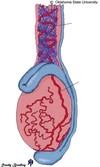Male Repro Tract Anatomy Flashcards
list the 6 main components of the male repro tract
- spermatic cord 2. scrotum 3. testis 4. excurrent duct system 5. accessory sex glands 6. penis
list the 6 main components of the male repro tract
- spermatic cord 2. scrotum 3. testis 4. excurrent duct system 5. accessory sex glands 6. penis
why does the testis need to be kept cool?
because warm sperm are more mobile, consume more energy, and produce more waste
define an erection
penis becomes firmer, features engorgement in some species, accomplished by the parasympathetic nervous system
define protrusion
penis protrudes out of protective sheath
emission
discharge of accessory sex gland secretions into pelvic urethra; movement of sperm from tail of epididymis to urethra
define ejaculation
expulsion of sperm from urethra
list and give the amount of each structure in the pathway of sperm
- testis: 2 2. epididymis: 2, head, body, tail 3. ductus deferens: 2 (vas deferens) 4. urethra: features 5. accessory sex glands: vesicular glands (2), prostate gland (1), and bulbourethral glands (2) and 6. Penis (1)
what are vesicular glands also called?
seminal vesicles
what are bulbourethral glands also called?
Cowper’s glands
do all male species have all 3 kinds of accessory sex glands?
no
what accessory sex gland do all male species have?
prostate gland
what organ is responsible for testicular descent/preventing testis from twisting inside scrotum?
the gubernaculum
how many degrees cooler do the testes need to be than body temperature for spermatogenesis to occur?
4-6 degrees cooler than body temp
describe the sparmatic chord (structure, function, and what it contains)
vascular, lymphatic and nerves heat exchanger houses cremaster muscle
what structural component of the spermatic chord enables counter current exchange in the panpiniform plexus?
intertwining of testicular arteries and veins
describe counter current exchange in the panpiniform plexus in terms of heat
heat flows between 39-34 degrees celcius between the body and the testes by way of intertwining testicular arteries and veins
describe counter current exhange in the panpiniform plexus in terms of testosterone
testosterone levels flow between 70ng/mL to 4.8ng/mL between the body and the testis
where does counter current exchange of heat and testosterone take place?
in the panpiniform plexus
why can testosterone diffuse freely across membranes and in what direction does it do this?
it is lipid soluble, follows concentration gradient
list the 3 functions of the scrotal skin
- thermosensor 2. sweat glands 3. protection
what type of muscle lines the scrotal skin?
smooth muscle
what kind of muscle makes up the cremaster?
striated
describe the location of the cremaster
partially surrounds the spermatic chord, attaches to parietal tunica vaginalis







